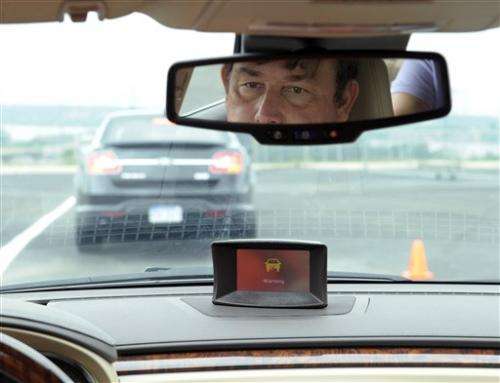US speeds research on car safety systems (Update)

The U.S. government is speeding up research on safety systems that automatically prevent drivers from operating their cars if they are drunk or aren't buckled properly.
Officials also said Thursday that they expect to decide by year's end how to encourage automakers to make available in more cars some special safety systems already in certain high-end vehicles. Those systems warn drivers before a collision that they are about to run into another vehicle, and can brake automatically to avoid a crash or make it less severe.
The innovations—collision avoidance, seat belt interlocks and driver alcohol detection systems—hold the potential of dramatically reducing traffic fatalities, according to the National Highway Traffic Safety Administration.
As they looked ahead to emerging safety technologies, officials released data showing the first increase in highway fatalities since 2005. There were 33,561 traffic deaths in 2012, 1,082 more than the year before.
"We need a new vision and a new blend of technological research to address some of the most significant and persistent threats to American motorists," the agency's head, David Strickland, said in a statement. "We must look to technological intervention to make the next great leap, and get them poised for fleet adoption as soon as possible."
The 3 percent increase in highway fatalities may be due in part to last year's unusually warm winter, which lengthened the motorcycle riding season. Seventy-two percent of the increase occurred in the first three months of the year. Most of those involved were motorcyclists or pedestrians, the government said.
The seat belt interlocks would prevent cars and trucks from being driven when the driver or a passenger isn't buckled properly. The agency said this potentially could save about 3,000 people a year who die in crashes that they could have survived were they belted in.
The agency is examining whether it should change safety standards to allow automakers to use the devices to satisfy other government crash test requirements. The research includes whether the interlocks can be made tamper-proof and highly reliable.
The "driver alcohol detection system" differs from devices already required by some states for drivers arrested or convicted of drunken driving. In those cases, drivers usually have to take some step—often breathing into a tube—to test their blood alcohol content before starting the car.
Detection systems such as those NHTSA is researching with automakers don't require any action on the driver's part except putting his hands on the steering wheel or pushing a start button with a finger. The idea is to eventually include the systems as standard or optional equipment in new vehicles, regardless of whether the driver has a history of drunken driving.
"The automatic system would be enabled every time the car is started, but unobtrusive so it would not pose an inconvenience to the non-intoxicated driver," the agency said.
There were 10,322 people killed in drunken driving crashes last year, the agency said. Most of the drivers involved had a blood alcohol content of 0.15 or higher, nearly double the legal limit. "Such technology could save thousands of these victims every year," the agency said.
The collision avoidance systems address one of the most common types of auto accidents. Last year, one-third of all police reported crashes started with a one vehicle striking the rear-end collision with vehicle, the agency said.
© 2013 The Associated Press. All rights reserved.

















